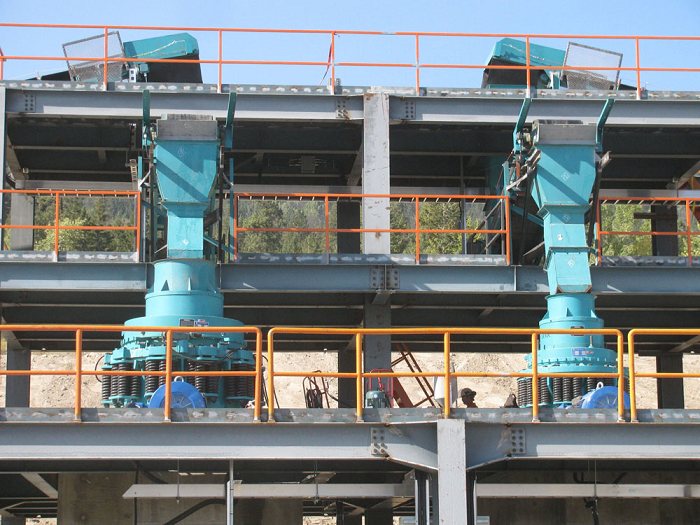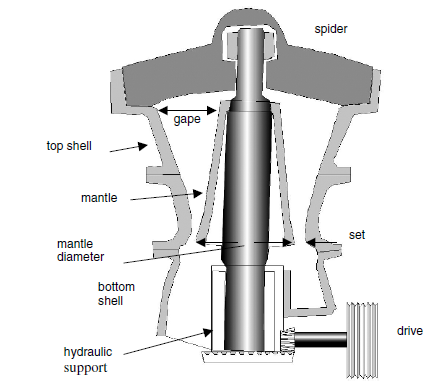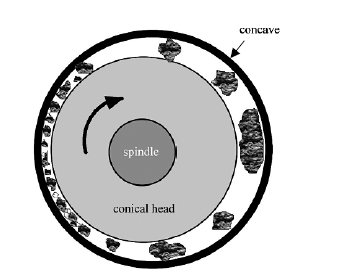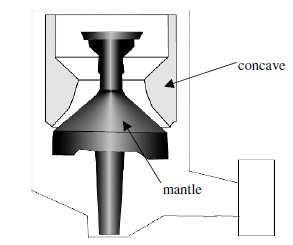Gyratory crushers were invented by Charles Brown in 1877 and developed by Gates around 1881 and was referred to as a Gates Crusher. The smaller form is described as a cone crusher. The larger crushers are normally known as primary crushers as they are designed to receive run-on-mine (ROM) rocks directly from the mines. The gyratory crushers crush to reduce the size by a maximum of about one-tenth its size. Usually metallurgical operations require greater size reduction, hence the products from the primary crushers are conveyed to secondary or cone crushers where further reduction in size takes place. Here the maximum reduction ratio is about 8:1. In some cases installation of a tertiary crusher is required where the maximum reduction is about 10:1. The secondary crushers are also designed on the principle of gyratory crushing but the construction details vary.

Similar to jaw crushers, the mechanism of size reduction in gyratory crushers is primarily by the compressive action of two pieces of steel against the rock. As the distance between the two plates decrease continuous size reduction take place. Gyratory crushers tolerate a variety of shapes of feed particles, including slabby rock, which are not readily accepted in jaw crushers because of the shape of the feed opening.
Gyratory Crushers
Primary crushers are solidly built to receive large lumps of rock directly from the mines and designed for large tonnage throughputs. Basically gyratory crushers consists of a fixed solid conical shell or bowl (also called concaves) and a solid cone within the bowl called a breaking head (Fig. 1). The breaking head is fixed to a central spindle, which is hydraulically suspended or mechanically held from a spider. The bottom end of the spindle usually rests on a hydraulically supported piston. The bottom end of the spindle is connected to a bevel and pinion arrangement with straight or spiral teeth which on rotating by a journal moves the bottom of the shaft eccentrically. In some models, the spindle is fixed at the top and bottom and is made to move side-ways to impart the crushing action. The entire assembly can be visualised as a circular jaw crusher.
Fig.1 is a typical sketch of a large gyratory crusher used as a primary crusher to reduce the size of large pieces of rocks produced during blasting in mines. Variations in the design of the breaking head and the mantle have been adopted by different manufacturers. Such variations are adopted from studies on stress distributions of component parts endured during the crushing operation. Effort is also made to improve the efficiency of the mechanical movements of the eccentric shaft.

Fig1. Sketch of a Gyratory Crusher
The designs of the breaking faces differ with different manufacturers.. In so doing the crusher products have different size distributions. The movement of the mantle or conical head that performs the crushing action can be visualised in Fig.2 where it can be seen that as the feed drops down, the mantle squeezes it against the concave and fractures the rock.

Fig 2.Section of Gyratory Crusher.
When the mantle moves away during its cycle of gyration, the crushed rock slips down to be caught again between the mantle and the concave on the next cycle, resulting in further size reduction. The process is repeated until the sizes of the broken rock are less than the open set at the bottom of the crusher.
Secondary and Tertiary cone crushers
Cone crushers were originally designed and developed by Symons around 1920 and therefore are often described as Symons cone crushers. As the mechanism of crushing in these crushers are similar to gyratory crushers their designs are similar, but in this case the spindle is supported at the bottom of the gyrating cone instead of being suspended as in larger gyratory crushers. Fig.3 is a schematic diagram of a cone crusher. The breaking head gyrates inside an inverted truncated cone. These crushers are designed so that the head to depth ratio is larger than the standard gyratory crusher and the cone angles are much flatter and the slope of the mantle and the concaves are parallel to each other. The flatter cone angles helps to retain the particles longer between the crushing surfaces and therefore produce much finer particles.
To prevent damage to the crushing surfaces, the concave or shell of the crushers are held in place by strong springs or hydraulics which yield to permit uncrashable tramp material to pass through.
The secondary crushers are designated as Standard cone crushers having stepped liners and tertiary Short Head cone crushers, which have smoother crushing faces and steeper cone angles of the breaking head. The approximate distance of the annular space at the discharge end designates the size of the cone crushers.

Fig3. Sketch of a secondary cone crusher
The Standard cone crushers are for normal use. The Short Head cone crushers are designed for tertiary or quaternary crushing where finer product is required. These crushers are invariably operated in closed circuit. The final product sizes are fine, medium or coarse depending on the closed set spacing, the configuration of the crushing chamber and classifier performance, which is always installed in parallel.
Gyratory and cone Crusher Circuit
In practice, large primary gyratory crashers are seldom installed underground. They are invariably installed at the surface. The charge is preferably fed directly off trucks, tip-wagons, side dump rail cars, and conveyor belts on to a receiving hopper, which feed the crusher through a chute. Usually a grizzly is placed prior to the feed entering the crasher to remove extra large pieces, which tend to jam the operation. Gyratory Crushers are invariable operated in open circuit.
When a choice has to be made to include a gyratory or a jaw crasher in a circuit, a general rule of thumb is to examine the desired production rate. Where the production rate required is in excess of 900 t/h, gyratory crashers are always the preferred option.
The primary gyratory crushers operate in open circuit while the last stages, either the secondary or tertiary crashers are invariably configured to operate in closed circuits in series with the primary crasher.
The need for the secondary crusher is dictated by the size of the product required. The product size from a primary crasher is limited by the possible reduction ratio, which normally is around 10:1. The feed size to a primary crasher from the mines could be 1 to 1.5 m thus the maximum product size possible is 10 to 15 cm which is normally too large for down stream processing for mineral liberation. Hence secondary and possibly tertiary crasher stages form part of the crashing circuit design.
The final product size from the circuit depends on the close set of the secondary crasher and on the screen apertures. The same logic is used where the final product size requires the installation of tertiary crushers.
To develop a crashing circuit it is useful to remember that the ranges of reduction ratios of crashers are:
• Primary crusher 3:1 to 10: 1
• Secondary crusher 6:1 to 8:1
• Tertiary crusher = 10:1